▼项目总览
Overview of the project
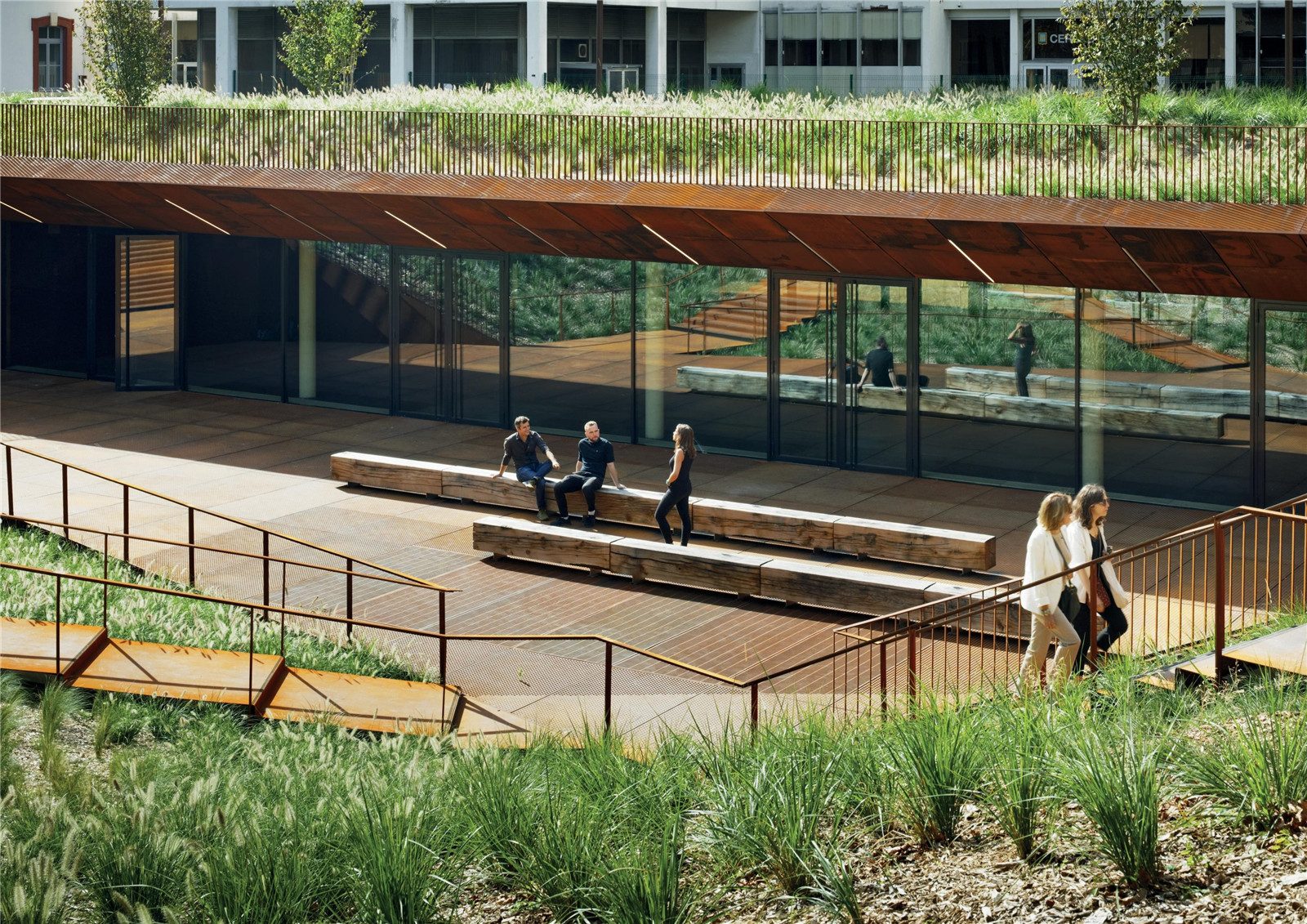
长期以来,“在城市上建造城市”一直是城市更新的标准做法。然而,我们的城市现代化在很大程度上忽视了这一理念,并将问题复杂化。由于严峻的环境问题给建筑业带来经济方面的现实挑战,这种做法再次兴起,且比以往更受青睐。
重视现有建筑的修缮与保留,甚至超越了作为遗迹来考量,正成为一种可行的建造方式,这既节省能源又理性清晰,也是可循环材料的来源,还是在建筑物功能的转变中探索新用途的绝佳机会。进入到这样一栋建筑中,它不仅承载着过去的生活记忆和历史变迁,展现着以往的功能,建筑古老的故事还丰富了畅想,孵化出新故事,将想象照进现实。
这也是为什么我们喜欢用“蜕变”这个词,而不是“复原”的原因:对我们来说,它意味着在旧物的基础上创造出新生事物,这比单纯意义上的“保留”潜藏着更丰富的内涵。
由于要将改造场地与现存建筑间建立起新的连系,再加上项目规模带来的挑战,设计团队在改造巴黎第13区露尔辛兵营项目时进行了大胆创新。在这个建筑密集、富有活力的中心城区,兵营已成为一个独特的区域,将其开放的空间与周边环境融合重塑,许多新的故事将被讲述。这种演变基于对巴黎遗产的重新开发,项目方案并不主张打造一座将被时间冰封沉寂的博物馆,而是让街区再次焕发新生,成为城市振兴的一种方式。
"Building a city on a city" has long been the standard approach to urban renewal.Our modernity has largely ignored and further complicated this practice that is now coming back all the more strongly due to the economic realities of construction being challenged by the severity of environmental issues.
Rehabilitating and preserving existing buildings, even over and above considerations of heritage, is becoming a viable means of saving energy and sobriety, a source of reusable materials and a great opportunity to discover new uses resulting from conversion. Entering a building with its past life and its history, its previous uses, means imagining new stories to tell based on older tales and the richness of their promise.
That is why we like to use the term "metamorphosis" rather than rehabilitation: for us, it means building on the old to create something new and richer still than what might have been preserved.
The project to transform the Lourcine barracks in the 13th Arrondissement of Paris is ambitious and innovative, due to both its scale and above all to the new relationship it creates with the existing buildings. In the heart of a very built-up and innervated district where the barracks has hitherto formed a distinct area, opening up the site to its immediate environment helps to tell those new stories. This evolution is based on an approach to the redevelopment of Parisian heritage, which in this case is envisaged not so much as a museum exhibit frozen in time, but as a means of regenerating the city, capable of breathing new life into the district.
▼项目效果
Effect drawing of the project
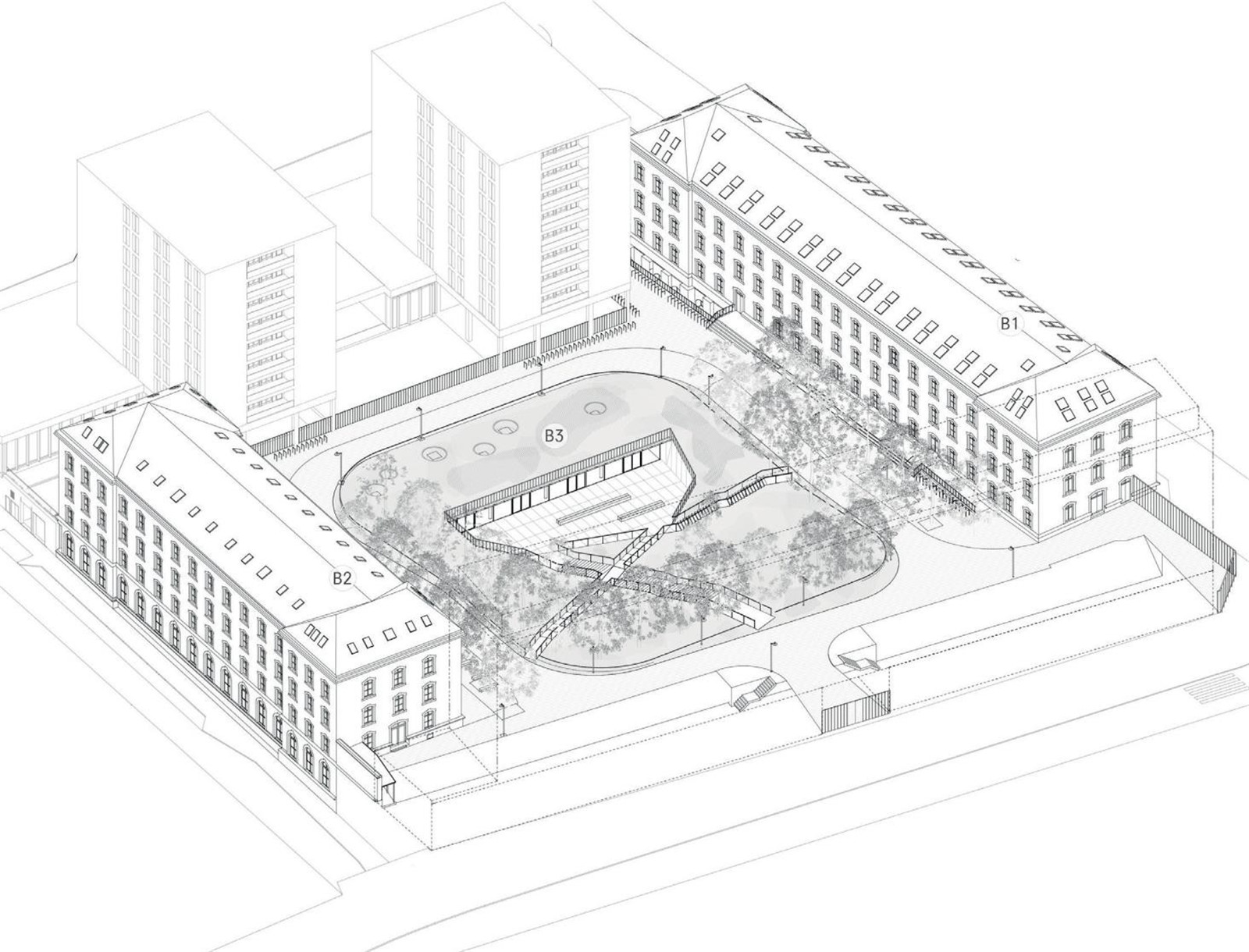
▼露尔辛兵营场地的蜕变
"metamorphosis" of the Lourcine barracks
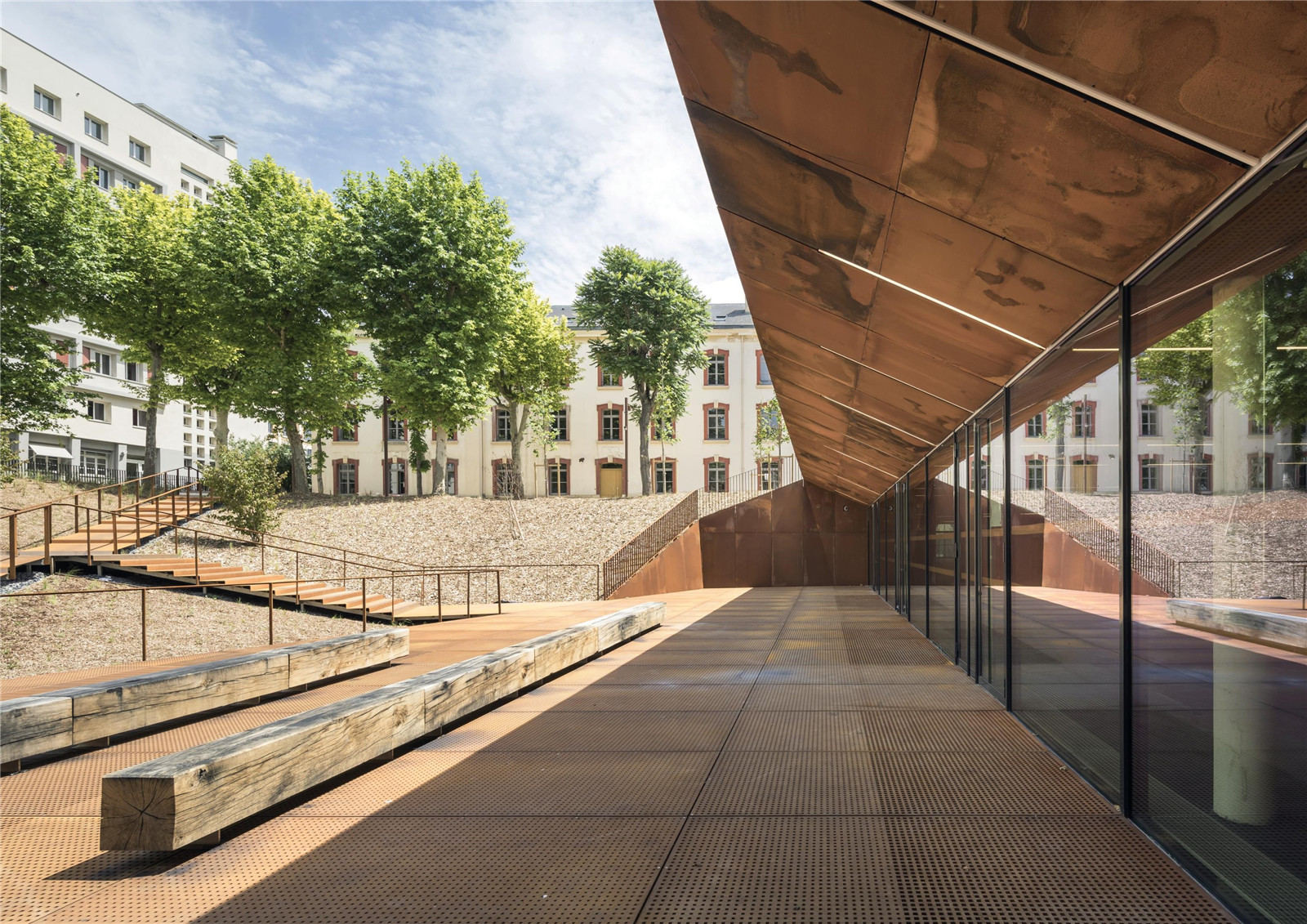
▼户外庭院
The outdoor courtyard
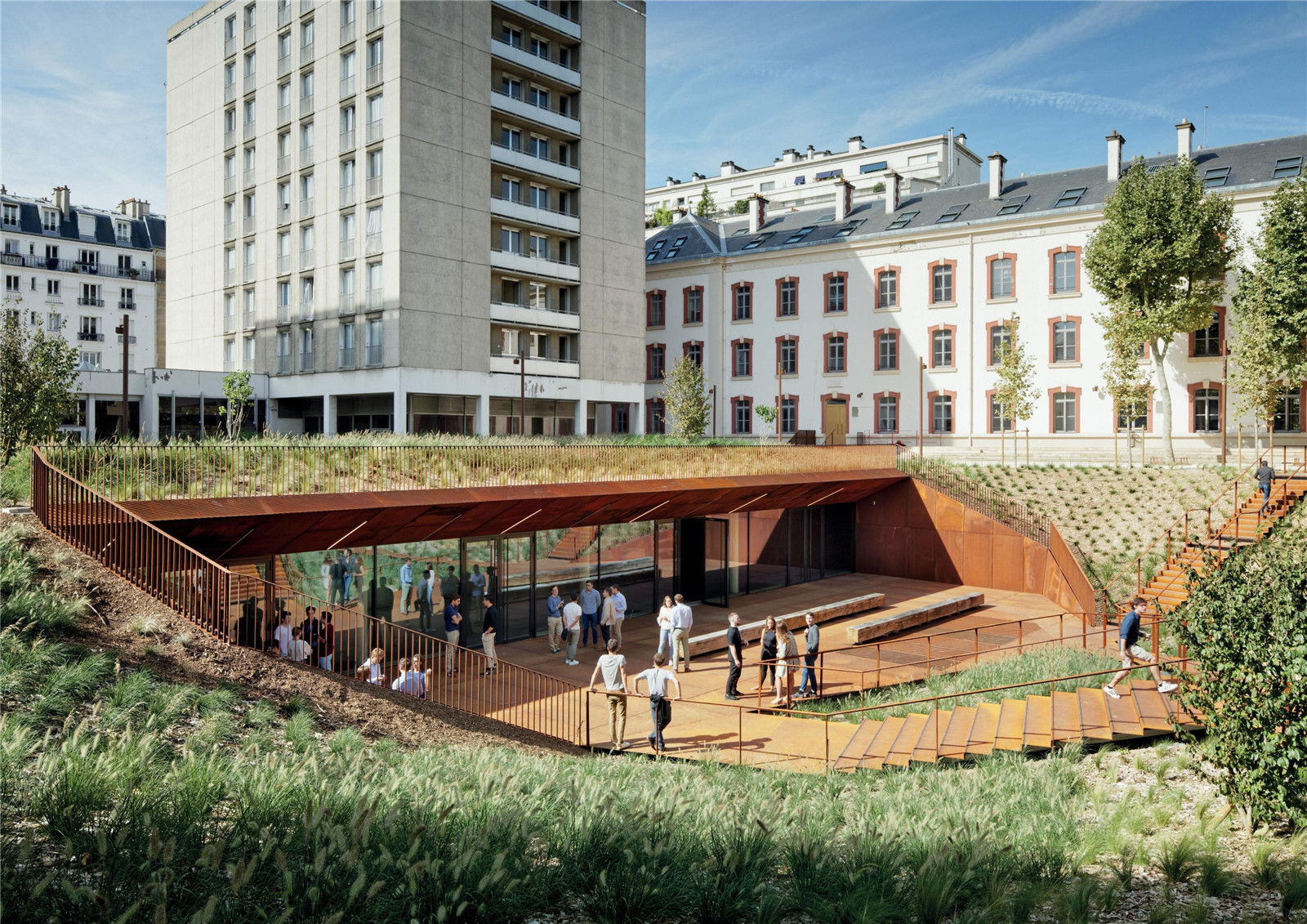
坐落在20世纪巴黎城市规划核心地带的军事基地
A military site at the heart of urban planning in Paris in the twentieth century
▼兵营旧建筑
Old barracks building
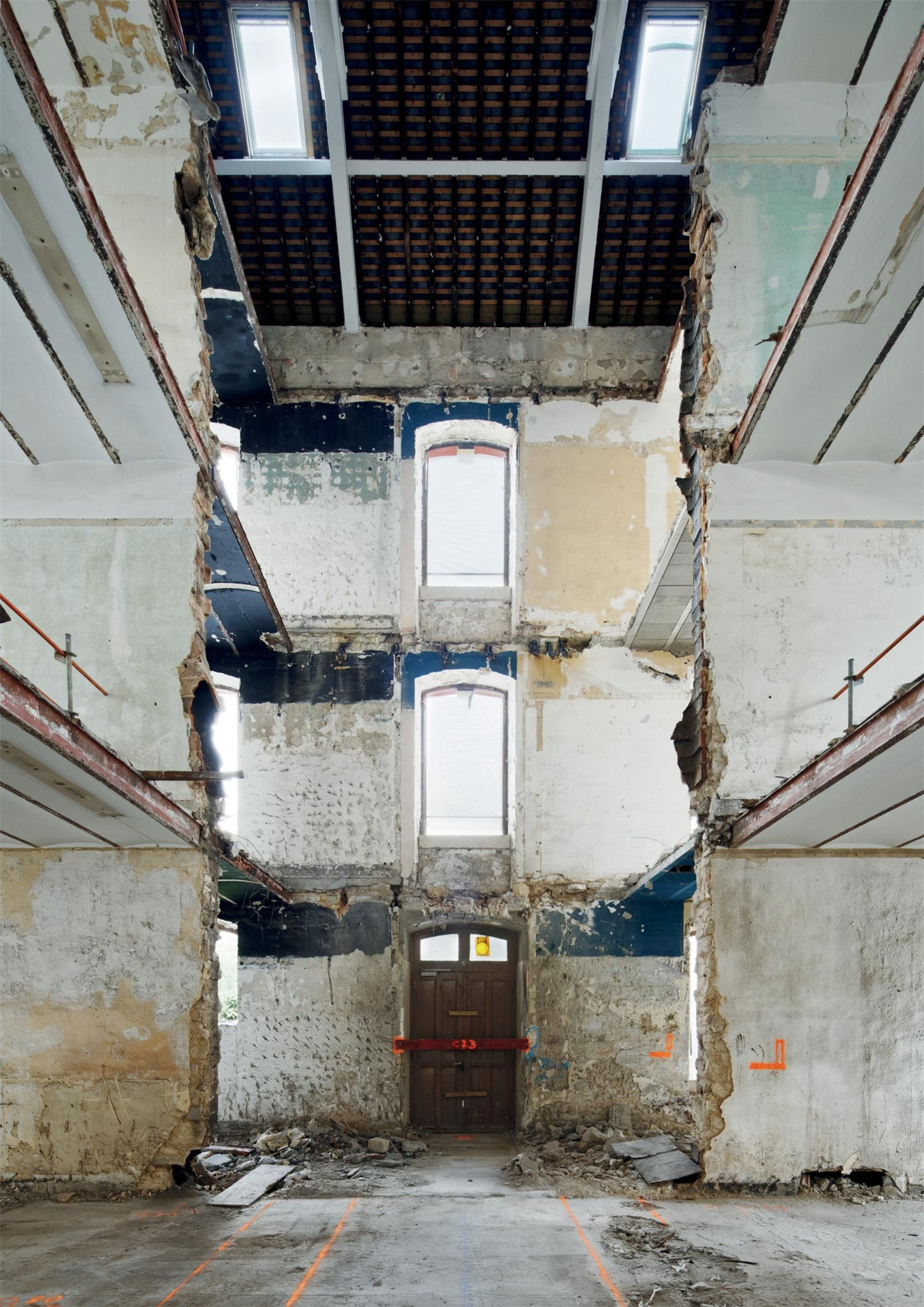
早在法国大革命之前,这里就已经是军事基地。自19世纪末以来,一直保持着现有状态。露辛尔兵营场地内的地形在阅兵场和皇家港大道之间趋于平坦,并向拉格拉西尔街略有倾斜,但在东侧的布罗卡街(一条中世纪的古老街巷)地势低了近5米。
这使得自然光线得以通过具有主要地基结构的大窗户,照进2号建筑物的地下室。这种地形营造形式展示了19世纪的主要土方工程的发展。
While this had been a military site since well before the French revolution, it has been in its current configuration since the end of the nineteenth century. The topography of the land in the Lourcine barracks presents a flat area between the parade ground and Boulevard de Port Royal and a slight slope towards Rue de la Glacière, but on the eastern side Rue Broca (an ancient medieval lane) is almost five metres lower.
This allows for natural light to enter the basement floors of building 2 through large windows with a major foundation. This topography bears witness to the major earthworks and development undertaken in the nineteenth century.
▼自然光线通过大窗扇照进建筑中
The natural light enters the building through large windows.
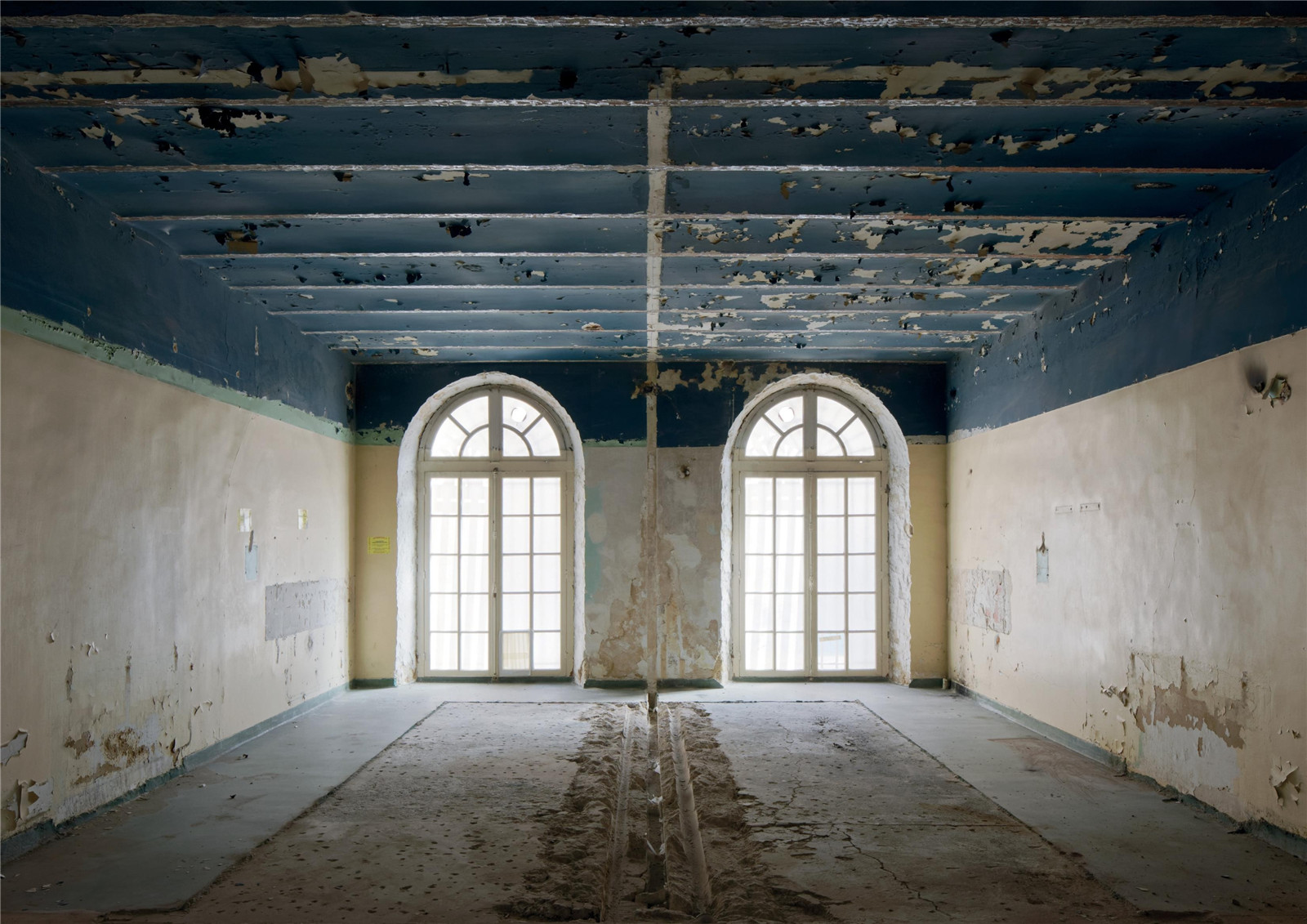
场地的中心区域是一座有树木的、大型矩形阅兵场,其两侧围有高大的营房(1号与2号建筑物),每座营房都由主体结构及两翼组成。这两栋原始建筑毫无疑问是分两阶段建造的,参照了传统的建筑营造制式,使用的建材包括修饰过的石头、碎石和砖,以及木质框架结构和石板屋顶。
20世纪下半叶,该场地经历了系列变化,面对着皇家港大道与圣希波吕特街上的建筑被拆除,并新建了两座宏伟的建筑物,以保持南北轴线对应的格局。在圣希波吕特街一侧,一座双层停车场设置在建筑物之下,与斜坡齐平,凸出向阅兵场。
In the centre, a large, rectangular parade ground planted with trees and surrounded on both sides by substantial barracks (buildings 1 and 2), each consisting of a central portion with wings at either end. These two original buildings were doubtless built in two phases using dressed stones, rubble and brick with a wooden frame and a slate roof according to a classical architectural model.
The site evolved in the second half of the twentieth century with the demolition of buildings facing Boulevard de Port Royal and Rue Saint Hippolyte and the construction of two imposing buildings maintaining the composition of the north / south axis. On the Saint Hippolyte side, a two-floor car park was created under the building up to the level of the slope and protruding into the parade ground.
建立在军事基地上的大学教研空间
A university teaching and research programme on a military site
▼由军事基地转变为大学校园景观
From a military site to a university landscape © Camille Gharbi
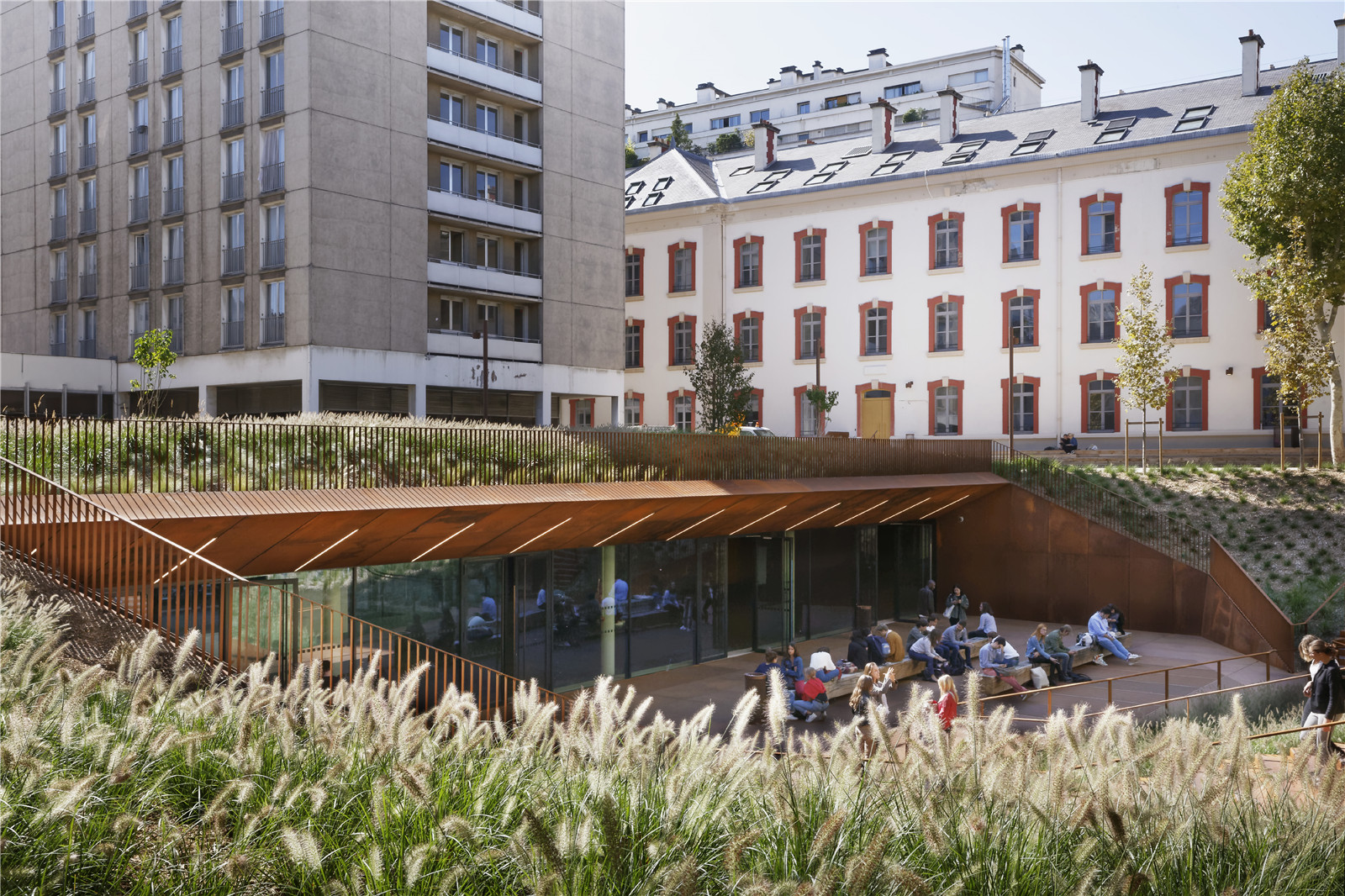
▼古旧形式,崭新功能
Original form,New functions
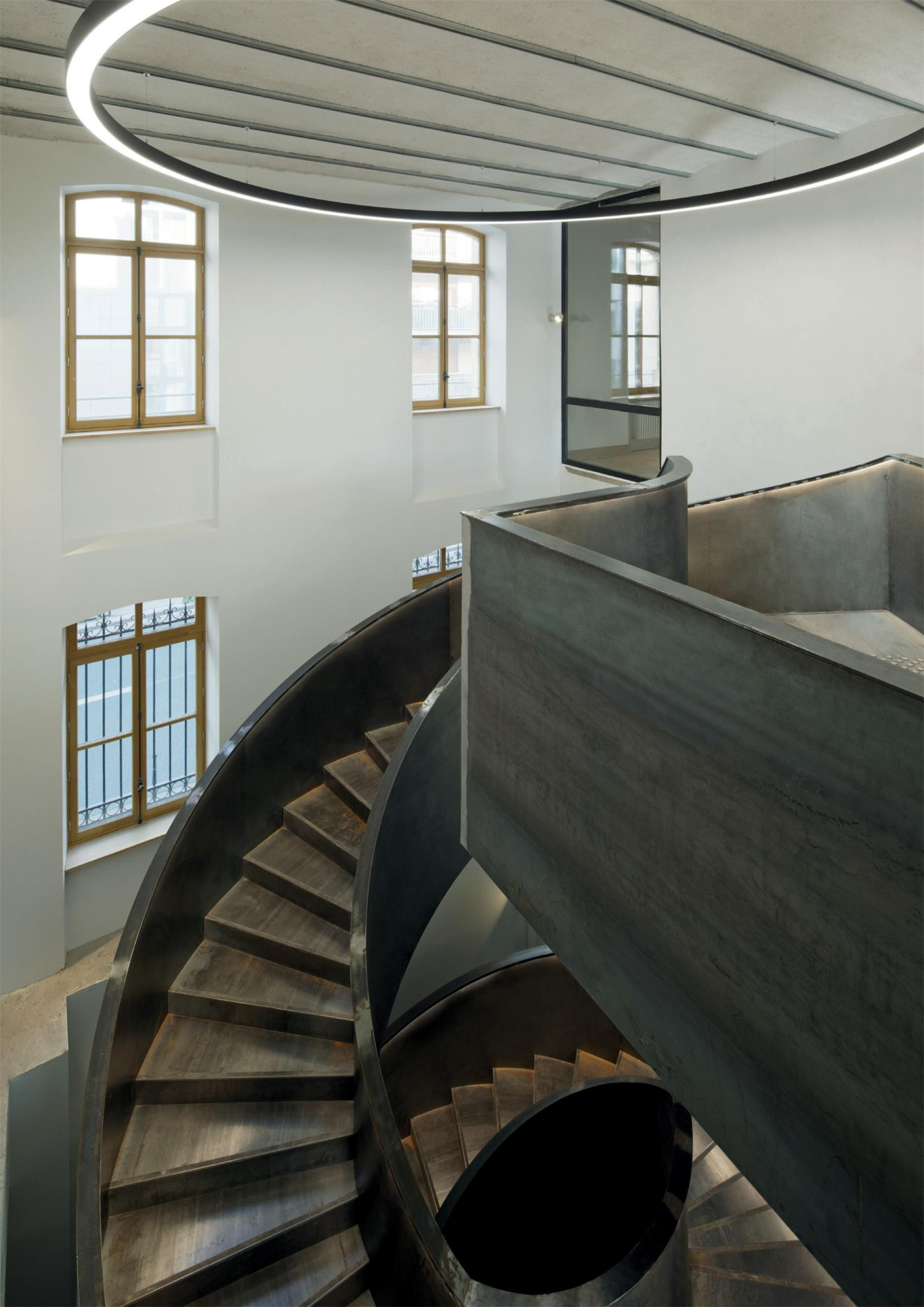
露尔辛兵营场地已发生相当大的变化,集办公与住宿于一体,但保持了阅兵场周围的原有形式,也保留了南北主轴线。这两栋军事建筑物的空间大小和大部分内部布局也都沿用了下来。
重建规划包括在1号与2号建筑物内部,以及3号建筑物地下室的部分空间内设置巴黎第一大学法学院的教学与研究设施,以及图书馆与中心复印室。
3号建筑物(地下室和上层建筑的部分空间)与4号建筑物不包含在当前项目范围内:3号建筑物为法国国防部的房屋住宅,4号建筑物则容纳了在让•扎伊中学学习预科课程的住宿学生。
该项目面临的挑战是保护这一见证了该地区城市发展史的珍贵遗址,同时带来尽可能少的变动。项目的设计旨在转变兵营建筑的组织方式,以完美适应其新的预设功能。
The site of the Lourcine barracks has evolved considerably, becoming a set of office buildings and accommodation, but keeping its original form around the old parade ground and its major north / south axis. The two military buildings have been preserved both in terms of their volume and a large part of their internal layout.
The redevelopment plans include the installation of a part of the Law Faculty of the Université Paris 1 (teaching and research facilities, a library and central copying room) in buildings 1 and 2, and in part of the basements under building 3.
Buildings 3 (a part of the basement and the superstructure) and 4 are not included in the scope of the current project: building 3 houses accommodation managed by the French Ministry of Defence and building 4 houses boarders taking preparatory classes at the Lycée Jean Zay.
The challenge for the project is to preserve a precious heritage that bears witness to the urban history of this district while altering it as little as possible. The idea is to change the organisation of the barracks buildings to perfectly suit their new intended functions.
▼转变场地的组织方式来适应新的预设功能
Changing the organisation to perfectly suit new intended functions.

两大策略连接庭院高差
Two major choices lead to a project making a connection via the garden level that reveals the topography of the site.
▼改造后的优美庭院,流畅的地形设计
Beautiful courtyard after renovation,with smooth topography

通过对1号和2号建筑物的小规模干预来展示这一遗产
Showcase this precious heritage by minor interventions on buildings 1 and 2
建筑物的质量和容纳量已使它们成为教学与研究的绝佳场所。为了满足隔声隔热性、可达性、安全性而进行结构调整都是可实现的,如果项目设计根据现场空间因地制宜,例如保留现有楼梯,甚至可以进一步减少调整。
这些建筑的改造设计都目标明确,且只限于内部:在现实条件许可的情况下,除了改变通向外部的门的尺寸以符合现代标准外,建筑外观上几乎完整保留下来。规划所有工作时,也确保粗略的改善让原有结构和原始材料的质感依然可见。
内部墙面通过宽阔的过道得以展示,原始立柱构造出的空阔感则更加彰显了空间的高度。
the quality of the construction and their capacity already make them a wonderful place to house the research and teaching programme. Structural adaptations for insulation, access and safety are all possible and can even be further reduced if the project is carefully adapted to the existing spaces (conservation of the staircases, for example).
Work on these buildings is carefully targeted and limited to the interior; the envelope remains almost untouched apart from altering the size of the doors leading to the outside to comply with modern standards but within the existing clearance. The works have been planned to ensure that the rough finishing leaves the existing structure and the nobility of the original materials visible.
The internal façades are revealed by generous walkways, while the height is emphasised by shafts that show off the existing volumes.
重建中心广场的战略功能:
Re-establishing the strategic function of the central square:
巴黎1号的未来建筑、军事住宿区、预科学生宿舍等不同功能的共存,给广场设计带来了挑战:这是一处交汇与分离相融合的流动空间,设计必须延续场地原有的整体基调,同时避免不同使用者间的不必要冲突。
因此,广场不能说是被“建造”,而应该是被“修复”:这也是为什么接待区的设置以微知著,代表着项目里精巧而细致的特点。
接待区的设置在赋予场地整体基调和凝聚力的同时,也起到引导作用,是一处有吸引力,且兼具功能性和娱乐性的空间。这种重组为该中心区域增添景观和功能层面上的价值成为可能。
该区预设为内部地形,通过地面微小的褶皱和平缓斜坡的形式,以最小的干扰将不同高度层次的地形连接为一体。
The co-existence of different uses, namely the proximity between the future premises of Paris 1, the military accommodation and the rooms for students taking preparatory classes make the square something of a challenge: a place where flows both converge and separate, it must make it possible to preserve the overall sense of the site while avoiding any undesirable confrontations between users.
The square must not therefore be "built", but rather restored: that is why the placement of the reception area represents a particularly sensitive feature of the project.
While giving the site its overall sense and cohesiveness, the location of the reception area calls out, offers guidance and plays the part of an attractive, functional and pleasant space. This reorganisation makes it possible to add value to the centre in terms of both landscaping and functionality.
Envisaged as an interior geography, it links together different topographic levels through folds in the ground or gentle dips with minimum interference.
▼内部地形设计
An interior geography © Camille Gharbi
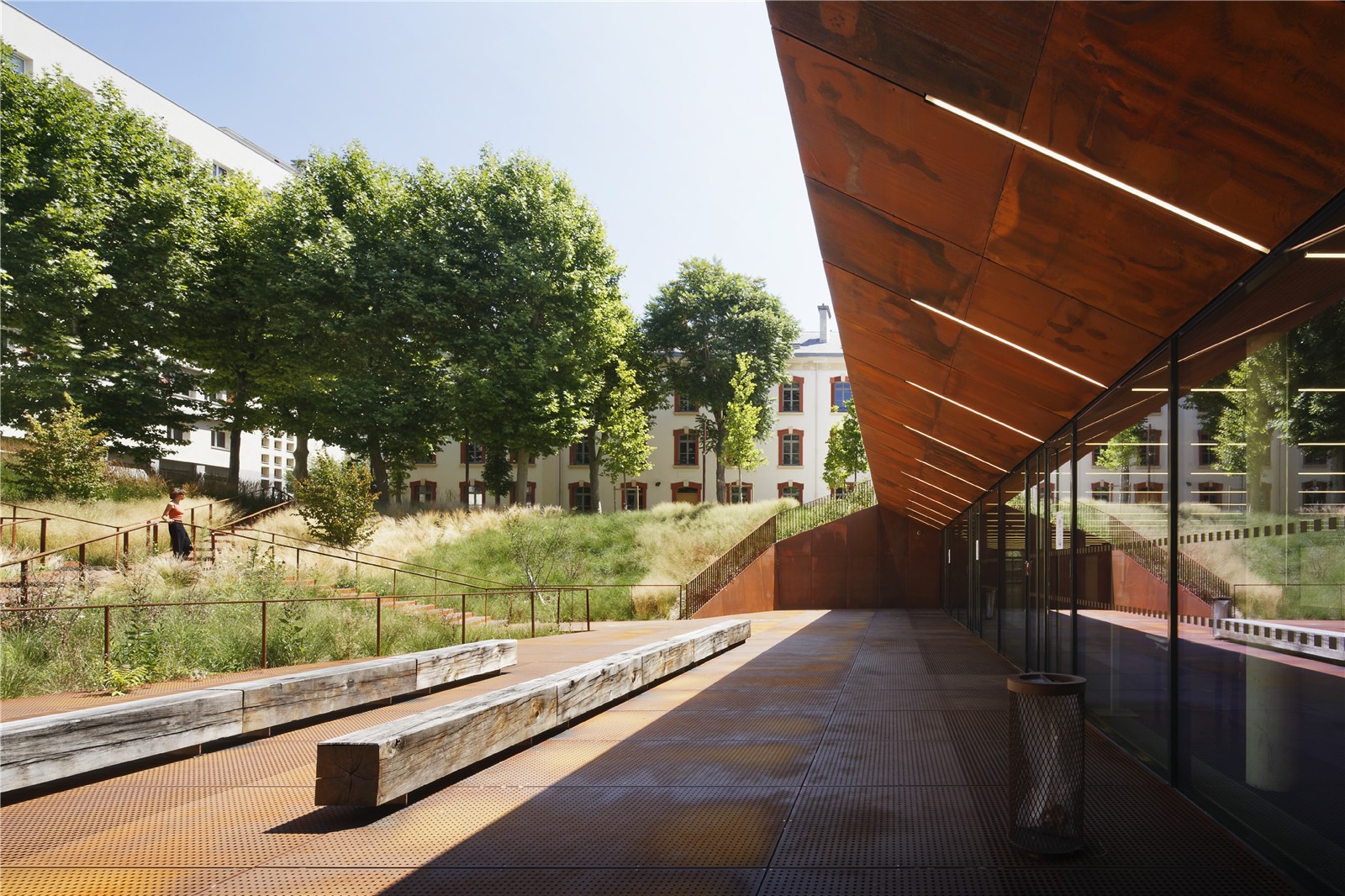
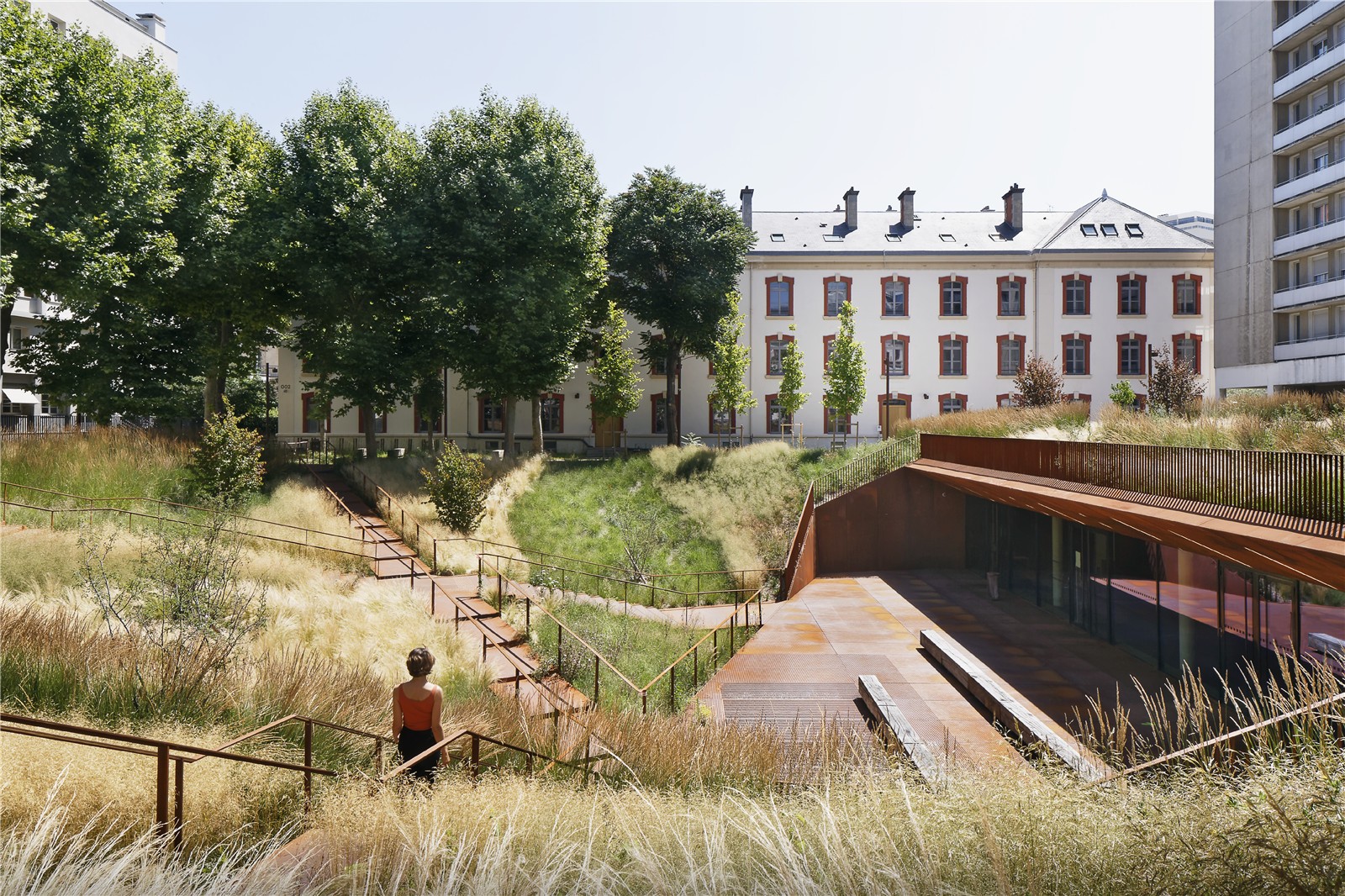
此外,整个区域的对称布局带来了视觉上的连接感,场地的贯通展示出从圣希波吕特街到皇家港大道的景观深度。
1号和2号建筑靠近3号建筑的地下室,使得在不干扰景观的情况下连接3个单元成为可能。接待区也为教学区、图书馆与研究区的可达性提供了便利。我们希望将这个“分流平台”打造成整个场地的活力中心。
改造区位于广场地势较低的地方,从而引导来访者自然地下行,这块下沉的场地也构成了露尔辛广场的中心区。正是这个中心位置,使得它成为1号建筑中图书馆的出入口,穿过下沉入口便可直达。同时,它也为建筑上层提供了通行线路。
在另一侧,从同一个中心点出发,学生们沿着阶梯教室能够到达位于布卡罗街的大教室,以及2号建筑上层的所有教学设施。
Furthermore, the symmetrical layout of the whole enables a visual link to be envisaged that runs right through the plot revealing the depth of the whole area from Rue Saint Hippolyte to Boulevard de Port Royal.
The proximity of buildings 1 and 2 to the basement of building 3 makes it possible to create a link connecting the 3 units without affecting the landscape. With this reception hub it is possible to access both the teaching areas and the library and research areas. We wanted to make this "distribution platform" the living heart of the site.
The programme installed on the lower level of the esplanade, which leads you down naturally, constitutes the heart of the Lourcine site. It is this central point that provides access to the library, located in building 1, via a direct link that crosses the sunken entrance and also provides access to the upper floors.
On the other side, it is from the same central point and by following the amphitheatre, that the students can access the magnificent classrooms on Rue Broca, and all the teaching facilities located on the upper floors of building 2.






